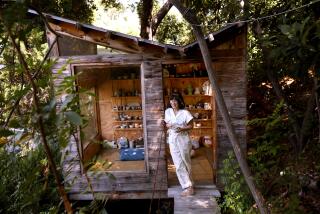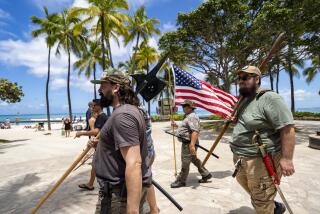Hawaii keeps the lei-making tradition alive
- Share via
Kula, Hawaii
While the rest of the world celebrates May Day on Thursday, in Hawaii it will be Lei Day.
For centuries, leis have been synonymous with “aloha” in Hawaii. Polynesian voyagers carried them in their canoes when they discovered and then settled the islands 1,000 years ago.
Leis are found virtually everywhere in the 50th state, at stalls in airports as well as high school football fields, where the players think nothing of draping a dainty chain of orchids over their bulky shoulder pads before kickoff.
In 1928, residents of Honolulu were encouraged to wear leis on May 1 to celebrate the ancient tradition. The next year, territorial legislators made Lei Day a holiday throughout the islands.
After languishing over the years, Lei Day is again popular thanks in part to renewed interest in the preservation of the islands’ culture. A variety of special events, including lei-making contests and pageants of dances and songs, begins on May 1 and continues for a couple of weeks.
Visitors to the islands -- who also can create leis in classes offered at some hotels, community centers and parks -- are welcome at the festivities.
When students arrive Thursday morning at Waihee Elementary School in Wailuku, Maui, many will be wearing leis they have made. The children use seeds, leaves, nuts and, of course, flowers from their family gardens to create their leis. Prizes will be awarded, in various age groups, for most creative and most beautiful leis.
“Each year we get more participants,” says Faith Tokeshi, the school principal. “Every grade gets to go in the library and see all the leis on display.” She explains that such observances are particularly important in a school such as hers in Wailuku, where nearly half of the children are ethnic Hawaiians. “The kids enjoy learning about their culture,” Tokeshi adds.
At the end of May, leis will again be plentiful, this time at the state’s high schools, where leis are as much a part of graduation ceremonies as caps and gowns. In recent years, the tradition has spread to college and university campuses on the mainland, with vendors selling floral leis on graduation day.
“The giving of a lei is still a very, very common practice here” and not just during May, says Teena Rasmussen, a flower grower on Maui for more than 30 years.
Locals won’t be greeting mainland visitors with a lei, she says, “but they are going to take it to a birthday party, a retirement party, a baby luau. If you’re giving a luncheon and you have a special speaker, they’re going to get a lei. If you have government officials coming around, they’re going to get leis.”
Many of the flowers in those leis are from Paradise Flower Farms in Kula, the business Rasmussen runs with her husband, Craig. Each year their plants on the slopes of the towering Haleakala Volcano produce more than 3 million blossoms.
When Teena’s parents moved to Maui from Idaho in 1976, carnations were the only flower commercially grown for leis. “A carnation lei was considered the crème de la crème of leis,” she says.
But over the years, the demand for more variety -- and more fragrance -- has grown. Now, Rasmussen’s firm supplies five types of flowers for leis. Orchids, plumeria and tuberoses are grown in the sunny, dry climate at an elevation of 1,600 feet. Carnations and roses are grown farther up the mountain -- at 3,400 feet -- where the climate is cooler and afternoon clouds provide accommodating shade.
Most of the blooms will be strung togetherby employees of Paradise Flower Farms and be sold at supermarkets, drug stores and airports. Even in laid-back Hawaii, people are often too busy to make leis from the flowers growing in their gardens. The remaining flowers -- a million or so -- are sold in bulk to those wanting to string together their own creations.
Boxes of the farm’s blooms are regularly delivered to the Kaanapali Beach Hotel in Lahaina, where guests can learn the basics of lei-making in hourlong classes.
“It’s not that hard, but you have to try to stay in the middle of the flower,” says Ursula Murker of Torrance as she assembles red, white and pink blooms in a class at the hotel. “It’s very fragrant, and it’s fun to do,” she adds. “But you have to try not to poke your finger!”
Murker is learning the kui -- or stringing -- method of lei-making, using flowers supplied by Paradise Flower Farms. Kui is one of three methods taught at the hotel. Instructor Malihini Keahi Heath, a guest services representative at the hotel, also teaches the braiding method, known as haku, and the twining method, known as wili, during lessons that are offered several days a week. In the haku class, ti leaves -- the leaves from which hula skirts are made -- are braided with brightly colored blooms to create headdresses.
Seated next to Ursula Murker is Gloria Goldsberry, a Nacogdoches, Texas, resident who is a third-time visitor to the Kaanapali Beach Hotel and its cultural classes, including lei-making. “It’s so much fun, and we learn about the culture,” Goldsberry says.
Keahi Heath, a Lahaina native whose “aunties” taught her how to make leis when she was a child, says she loves sharing Hawaiian traditions with her guests. “The traditions are passed on,” she explains. “If you don’t pass them on, they don’t live on.”
More to Read
Sign up for The Wild
We’ll help you find the best places to hike, bike and run, as well as the perfect silent spots for meditation and yoga.
You may occasionally receive promotional content from the Los Angeles Times.






